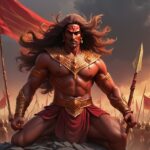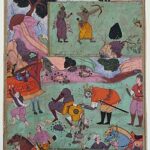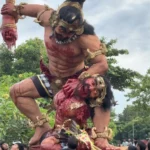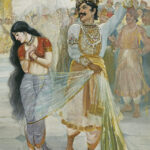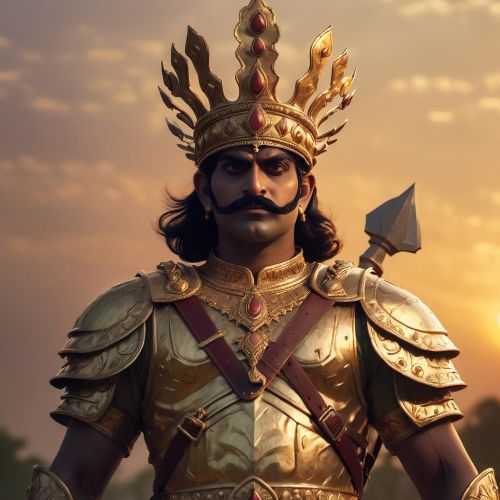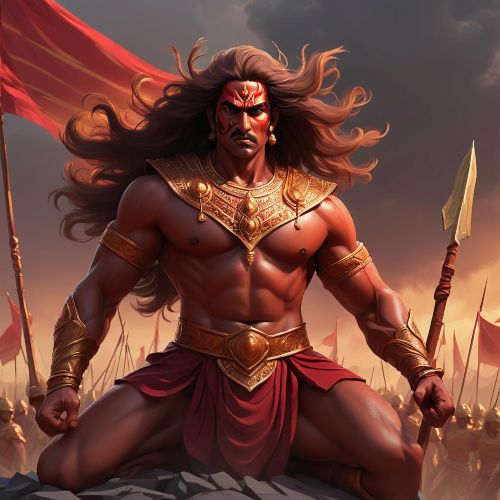
Dushasana : The Devoted Brother
Listen
At a glance
| Description | |
|---|---|
| Origin | Indian Mythology |
| Classification | Mortals |
| Family Members | Dhritarashtra (Father), Gandhari (Mother), Duryodhana & Kauravas (Brothers) |
| Region | India |
| Associated With | Evil, Royalty |
Dushasana
Introduction
Dushasana is one of the most infamous figures in the Indian epic, the Mahabharata. Known as the second son of King Dhritarashtra and Queen Gandhari, he is remembered primarily for his fierce loyalty to his elder brother Duryodhana and his role in the humiliation of Draupadi during the infamous dice game. His name, meaning “hard to rule,” reflects his rebellious and destructive nature. Though he was a skilled warrior and a central participant in the Kurukshetra War, his cruelty and blind allegiance to adharma ensured that his story became one of warning and downfall. Dushasana’s legacy continues to be discussed in religious, cultural, and academic contexts as a representation of unrestrained aggression and corrupted loyalty.
Physical Traits
Descriptions of Dushasana in classical texts are not very detailed, but artistic traditions have kept his image alive for centuries. He is often portrayed as tall, muscular, and imposing, with fierce eyes that highlight his aggressive nature. His strength was emphasized in his notorious act of dragging Draupadi into the royal court by her hair, an incident that branded him as the face of Kaurava arrogance. Sculptures in temples from Karnataka and Tamil Nadu depict him in the act of attempting to strip Draupadi, while paintings and theatrical retellings show him clad in armor, symbolizing his warrior status. These portrayals consistently stress his brutality, making his physical form inseparable from his violent deeds.
Family
Dushasana was born into the Kuru dynasty as the second son of Dhritarashtra and Gandhari. His elder brother was Duryodhana, the leader of the Kauravas, and together they became the chief antagonists of the Pandavas. His birth, like that of his ninety-eight brothers and sister Duhsala, followed Gandhari’s prolonged pregnancy, during which a mass of hardened flesh was divided into one hundred and one pieces by the sage Vyasa. These were incubated in pots of ghee, producing the siblings who would shape the epic’s conflicts. Dushasana also had a half-brother, Yuyutsu, who later sided with the Pandavas during the war. His own son, Drumasena, participated in the Kurukshetra War and was killed by Satyaki. Above all, Dushasana’s role within the family was defined by his unwavering devotion to Duryodhana, serving as his most trusted enforcer.
Other names
The name Dushasana appears in several variations across manuscripts and translations of the Mahabharata. He is referred to as Duhshasana, Dussasana, or Duhsasana, each spelling derived from the original Sanskrit Duḥśāsana. The etymology combines duḥ (“difficult”) and śāsana (“rule” or “discipline”), yielding a meaning close to “hard to discipline” or “one whose conduct is corrupted.” This name is significant, as it aligns perfectly with his defiant nature and his role in carrying out Duryodhana’s most unrighteous schemes. Unlike some characters who are remembered by epithets of honor, Dushasana’s identity is tied entirely to his name of infamy.
Powers and Abilities
Although Dushasana did not possess divine weapons or supernatural blessings, he was a formidable warrior trained alongside his brothers by renowned teachers such as Drona and Kripa. His physical strength was extraordinary, allowing him to overpower opponents in hand-to-hand combat. During the Kurukshetra War, he fought with determination on many occasions: he shot the first arrow of the war, battled Nakula and Yudhishthira, defended Bhishma from Shikhandi’s attacks, and participated in the brutal killing of Abhimanyu. He also dueled with Arjuna and other great warriors but was consistently overpowered. His final confrontation came on the battlefield when Bhima fulfilled his terrifying vow to kill him, tearing open his chest and drinking his blood as Draupadi’s vengeance was realized. This gruesome end immortalized Dushasana as a symbol of the terrible consequences of cruelty.
Modern Day Influence
The legacy of Dushasana extends far beyond the Mahabharata into literature, performance, and social commentary. His attempt to disrobe Draupadi remains one of the most dramatized and retold episodes in Indian cultural history, appearing in television adaptations, theatrical traditions like Yakshagana and Kathakali, and modern films. The act is often highlighted not merely as personal cruelty but as a broader symbol of the oppression of women and the abuse of power. In popular retellings such as Chitra Banerjee Divakaruni’s The Palace of Illusions, Draupadi’s perspective reshapes the narrative, casting Dushasana as a reminder of male arrogance and injustice.
Artists have also immortalized him in sculpture and painting, often focusing on his violent death at the hands of Bhima. These depictions serve as cultural reminders of the fulfillment of justice, with Draupadi’s vow being dramatically realized. In religious practices across South India, rituals connected to Draupadi worship often symbolically recall the destruction of Dushasana and his brother, underlining their role as embodiments of adharma.
Beyond art and tradition, his name has become a metaphor in political and social discourse, representing enforcers of tyranny and figures who blindly follow corrupt authority. Scholars interpret him psychologically as the embodiment of inner chaos and lack of self-discipline, contrasted with the yogic principle of anushasana (self-control). In this way, Dushasana’s character continues to resonate not just as a villain of mythology but as a cautionary figure whose story remains relevant to modern reflections on justice, morality, and power.
Related Images
Source
Ernest, P. (2006). TRUE LIES – BHĪMA’S VOWS AND THE REVISION OF MEMORY IN THE ‘MAHĀBHĀRATA’S’ CODE. Annals of the Bhandarkar Oriental Research Institute, 87, 273–282. http://www.jstor.org/stable/41692062
Khair, T. (2018). The Mahabharata: A modern rendering. India Penguin Books.
Klostermaier, K. K. (2007). A concise encyclopedia of Hinduism. Oneworld Publications.
Morgan, K. (2011). The Mahabharata: A modern retelling. Harper Perennial.
Narayan, R. K. (1978). The Mahabharata: A shortened modern prose version of the Indian epic. Viking Press.
Sharma, K. (2006). Mahabharata: The greatest spiritual epic of all time. Sterling Publishers.
Sullivan, E. (2000). The complete idiot’s guide to the Mahabharata. Alpha Books.
Vakil, R. (n.d.). Duhshasana – the epitome of indiscipline and chaos. 3SRB. Retrieved August 22, 2025, from https://www.3srb.org/sri-rajen-vakil/articles-by-sri-rajen-vakil/mahabharat-articles/240-article-5-duhshasan
Wikipedia contributors. (n.d.). Dushasana. Wikipedia. Retrieved August 22, 2025, from https://en.wikipedia.org/wiki/Dushasana
Wisdom Library. (n.d.). Dushasana: Definition and meaning. Retrieved August 22, 2025, from https://www.wisdomlib.org/definition/dushasana
Kohli, S. S. (1993). Dictionary of mythological references in Guru Granth Sahib. Punjabi University. [No URL available—print source]
The Sikh Encyclopedia. (n.d.). Duhsasana. Retrieved August 22, 2025, from https://www.thesikhencyclopedia.com/duhsasana/
Frequently Asked Questions
What is lorem Ipsum?
I am text block. Click edit button to change this text. Lorem ipsum dolor sit amet, consectetur adipiscing elit. Ut elit tellus, luctus nec ullamcorper mattis, pulvinar dapibus leo.
What is lorem Ipsum?
I am text block. Click edit button to change this text. Lorem ipsum dolor sit amet, consectetur adipiscing elit. Ut elit tellus, luctus nec ullamcorper mattis, pulvinar dapibus leo.
What is lorem Ipsum?
I am text block. Click edit button to change this text. Lorem ipsum dolor sit amet, consectetur adipiscing elit. Ut elit tellus, luctus nec ullamcorper mattis, pulvinar dapibus leo.
What is lorem Ipsum?
I am text block. Click edit button to change this text. Lorem ipsum dolor sit amet, consectetur adipiscing elit. Ut elit tellus, luctus nec ullamcorper mattis, pulvinar dapibus leo.
What is lorem Ipsum?
I am text block. Click edit button to change this text. Lorem ipsum dolor sit amet, consectetur adipiscing elit. Ut elit tellus, luctus nec ullamcorper mattis, pulvinar dapibus leo.


